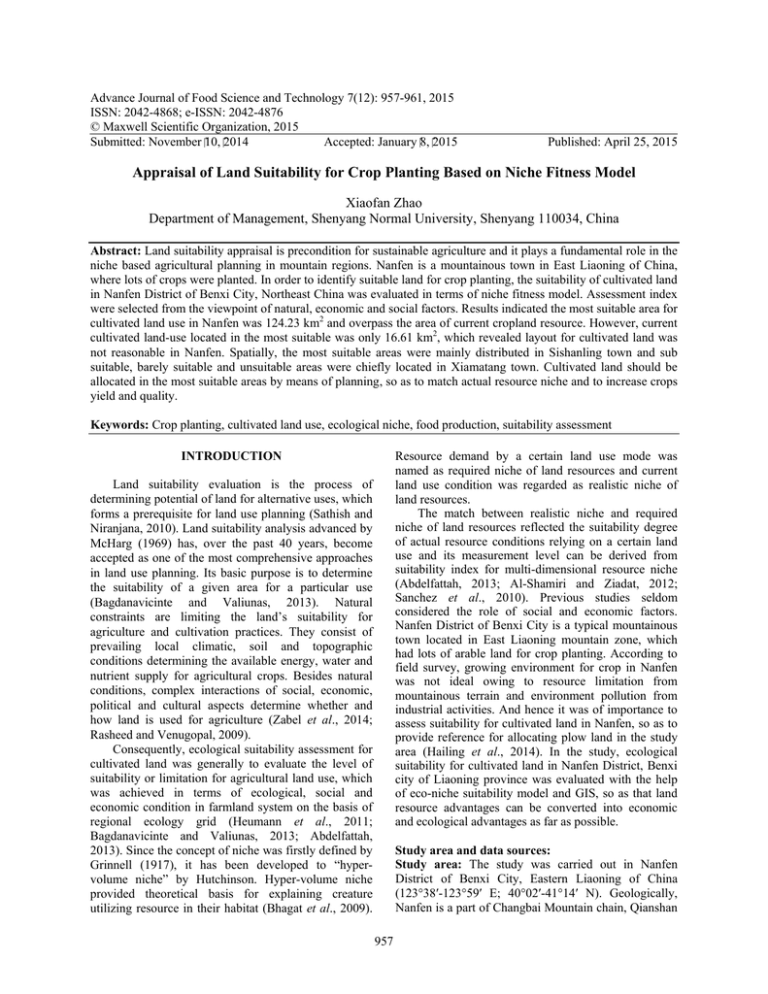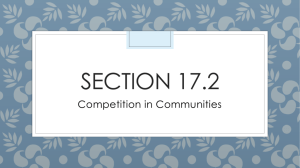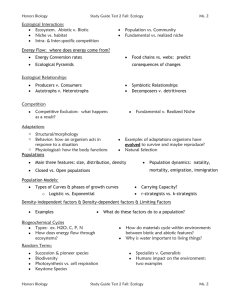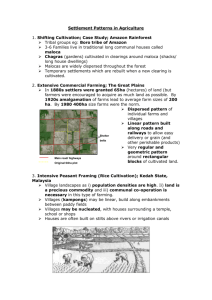Advance Journal of Food Science and Technology 7(12): 957-961, 2015
advertisement

Advance Journal of Food Science and Technology 7(12): 957-961, 2015 ISSN: 2042-4868; e-ISSN: 2042-4876 © Maxwell Scientific Organization, 2015 Submitted: November 10, 2014 Accepted: January 8, 2015 Published: April 25, 2015 Appraisal of Land Suitability for Crop Planting Based on Niche Fitness Model Xiaofan Zhao Department of Management, Shenyang Normal University, Shenyang 110034, China Abstract: Land suitability appraisal is precondition for sustainable agriculture and it plays a fundamental role in the niche based agricultural planning in mountain regions. Nanfen is a mountainous town in East Liaoning of China, where lots of crops were planted. In order to identify suitable land for crop planting, the suitability of cultivated land in Nanfen District of Benxi City, Northeast China was evaluated in terms of niche fitness model. Assessment index were selected from the viewpoint of natural, economic and social factors. Results indicated the most suitable area for cultivated land use in Nanfen was 124.23 km2 and overpass the area of current cropland resource. However, current cultivated land-use located in the most suitable was only 16.61 km2, which revealed layout for cultivated land was not reasonable in Nanfen. Spatially, the most suitable areas were mainly distributed in Sishanling town and sub suitable, barely suitable and unsuitable areas were chiefly located in Xiamatang town. Cultivated land should be allocated in the most suitable areas by means of planning, so as to match actual resource niche and to increase crops yield and quality. Keywords: Crop planting, cultivated land use, ecological niche, food production, suitability assessment INTRODUCTION Resource demand by a certain land use mode was named as required niche of land resources and current land use condition was regarded as realistic niche of land resources. The match between realistic niche and required niche of land resources reflected the suitability degree of actual resource conditions relying on a certain land use and its measurement level can be derived from suitability index for multi-dimensional resource niche (Abdelfattah, 2013; Al-Shamiri and Ziadat, 2012; Sanchez et al., 2010). Previous studies seldom considered the role of social and economic factors. Nanfen District of Benxi City is a typical mountainous town located in East Liaoning mountain zone, which had lots of arable land for crop planting. According to field survey, growing environment for crop in Nanfen was not ideal owing to resource limitation from mountainous terrain and environment pollution from industrial activities. And hence it was of importance to assess suitability for cultivated land in Nanfen, so as to provide reference for allocating plow land in the study area (Hailing et al., 2014). In the study, ecological suitability for cultivated land in Nanfen District, Benxi city of Liaoning province was evaluated with the help of eco-niche suitability model and GIS, so as that land resource advantages can be converted into economic and ecological advantages as far as possible. Land suitability evaluation is the process of determining potential of land for alternative uses, which forms a prerequisite for land use planning (Sathish and Niranjana, 2010). Land suitability analysis advanced by McHarg (1969) has, over the past 40 years, become accepted as one of the most comprehensive approaches in land use planning. Its basic purpose is to determine the suitability of a given area for a particular use (Bagdanavicinte and Valiunas, 2013). Natural constraints are limiting the land’s suitability for agriculture and cultivation practices. They consist of prevailing local climatic, soil and topographic conditions determining the available energy, water and nutrient supply for agricultural crops. Besides natural conditions, complex interactions of social, economic, political and cultural aspects determine whether and how land is used for agriculture (Zabel et al., 2014; Rasheed and Venugopal, 2009). Consequently, ecological suitability assessment for cultivated land was generally to evaluate the level of suitability or limitation for agricultural land use, which was achieved in terms of ecological, social and economic condition in farmland system on the basis of regional ecology grid (Heumann et al., 2011; Bagdanavicinte and Valiunas, 2013; Abdelfattah, 2013). Since the concept of niche was firstly defined by Grinnell (1917), it has been developed to “hypervolume niche” by Hutchinson. Hyper-volume niche provided theoretical basis for explaining creature utilizing resource in their habitat (Bhagat et al., 2009). Study area and data sources: Study area: The study was carried out in Nanfen District of Benxi City, Eastern Liaoning of China (123°38′-123°59′ E; 40°02′-41°14′ N). Geologically, Nanfen is a part of Changbai Mountain chain, Qianshan 957 Adv. J. Food Sci. Technol., 7(12): 957-961, 2015 Fig. 1: The location of study area Mountain eastern-extended section and possessing abundant arable land resources. Total land area in Nanfen was 619 km2, in which current arable land resources (including dry land, vegetable field, garden plot, etc.) was 70.89 km2, account for 11.5% of the total area. The area has a temperate monsoon climate, with distinct seasonal variations and a rather large temperature difference between winter and summer. At present, Nanfen District covers 619 km2, including 2 towns (Sishanling town and Xiamatang town) and an urban area, where Sishanling town covers 229 km2 with 9 administrative villages, Xiamatang town covers 212 km2 with 7 administrative villages and a community and urban area covers 178 km2 with 14 communities, 4 mining areas and 6 administrative villages (Fig. 1). (Zhao et al., 2013). Maps including topography, soil type and land use were overlaid in terms of GIS and the plot with the same geomorphic, soil and land use was divided into one ecological unit. 58276 evaluation units were acquired in the study area in total. Selecting ecological factors: Guided on the principle of dominant, difference, stability and data availability, 7 indicators involving slope, soil texture, organic content, soil pH, agricultural output value per land, density of road network and distance from town were selected from there aspects of natural, economic and social niche. Indicators classification about evaluation factors and evaluation index system were constructed in accordance with the actual situation of the study area (Table 1). Data sources: Vector data of land use and DEM (2010, 1:50,000) has been provided by Department of Land and Resources of Liaoning Province. Data about soil texture, soil PH and organic matter content came from soil survey in Nanfen. Agricultural output value and relevant maps about soil type, road network and administrative division has been obtained from government departments of Nanfen District. EVALUATION METHODOLOGY Establishing GIS database: Data management includes graphs and their corresponding attributes data (Chanhda et al., 2010). Graphic data were input in file format of Shape in Arc GIS by digitization, including the map of land use, village administrative division, soil type, DEM and traffic road map in the scale of 1:50,000. Their corresponding attributes data were managed in Arc GIS attribute library through the common field connecting with graphic data. Dividing ecological unit: Multi-factors overlay method was used to divide the assessment unit in the study Calculating niche fitness for single factor: For a specific land use, only when realistic conditions of land 958 Adv. J. Food Sci. Technol., 7(12): 957-961, 2015 Table 1: Indicator system for evaluating eco-niche fitness of cultivated land-use Suitability ratings -----------------------------------------------------------------------------------------------Unsuitable Barely suitable Sub suitable Most suitable Eco-niche Ecological factors Natural niche Slope (°) >25 15~25 8~15 <8 Soil texture Rock, gravel Sandy soil Clay Loamy soil Organic matter content (%) <10 10~20 >20 Soil PH <4, >8 4~5, 7~8 5~6, 6~7 Economic niche Agricultural output value per land <50 50~120 120~180 >180 (104 Yuan/km2/year) Social niche Density of road network (m/km2) <100 100~350 350~500 >500 Distance from town (km) >25 12~25 3~12 <3 resources can meet their demands, i.e., realistic niche can match with demand niche in land use system, rational land use can realize. They can be divided into 3 cases. For cultivated land use, positive acting factors involving organic matter content, agricultural production per unit land and density of road network should meet the minimum requirements and the higher was the better. Niche fitness index (X ij ) can be calculated using the Eq. (1): 0, When Si < Di min X ij = Si ⋅ Ri / Diopt, When Di min < Si < Diopt R, When Si > Diopt i D imin , D imax and D iopt = The lower limit, upper limit and ideal value of requirement for i resource factor, respectively Qualitative factors such as soil texture, which was difficult to describe them with the continuous number, were assigned by the Delphi method. In the study, soil texture for rock or gravel, sandy soil, clay and loamy soil was designed as 0, 0.25, 0.75 and 1.0, respectively. Calculating niche fitness for multi factors: According to Shelford's restrictive law, when any one ecological factor lies in the lack of quantity or quality, it should make species survive recess or disappear. Clearly, this law was also suitable to analyze the relationship between regional land use and their resource supply. When certain ecological factor fitness was zero, the entire niche suitability index was also zero. Niche fitness index of multi factors for cultivated land in Nanfen District can be calculated using the Eq. (4): (1) Negative acting factor such as slope and distance from town should be as low as possible. Niche fitness index (X ij ) can be calculated using the Eq. (2): X ij 1, When Si < Di min 1- ( Si - Di max ) / ( Di min - Di max )] ⋅ Ri,When Di min < Si ≤ Di max When Si > Di max 0, n X j = (∏ X ij )1/ n (4) i =1 (2) where, X j = Total niche fitness index of j development mode n = The numbers of factors Neutral acting factor such as soil pH should stay within an interval range, both not less than and not higher than a certain value. Too little or too much supply will both become constraint factor. Niche fitness index (X ij ) can be calculated using the Eq. (3): RESULTS AND DISCUSSION (3) Niche fitness index for each ecological unit was calculated applying niche fitness model in Arc GIS based on ecological unit map and frequency distribution of niche suitability index for each ecological cell was used to determine its suitability level (Table 2). Their corresponding spatial distribution can be acquired (Fig. 2). where, X ij = The niche fitness index of resource factor i for j development mode S i = The measure of reality for i resource factor R i = The measure of risk for i resource factor, which can be assigned as 50% in general D i = The measure of requirement of development mode j for i resource factor Quantitative characteristic of niche fitness for cultivated land-use: The most suitable area for cultivated land use in Nanfen District was 124.23 km2, including 6.76 km2 in urban area, 43.04 km2 in Xiamatang town and 74.43 km2 in Sishanling town. We can find that Sishanling town had the largest suitable area for cultivated land use, followed by Xiamatang town and urban area. Comparing with Xiamatang and 0,, When Si ≤ Di min Si ≥ Di max X ij = ( Si − Di min ) ⋅ Ri / ( Diopt − Di min ),When Di min < Si ≤ Diopt ( D − S ) ⋅ R / ( D − D ),When D < S < D i max iopt iopt i i max i max i i 959 Adv. J. Food Sci. Technol., 7(12): 957-961, 2015 Table 2: Ecological niche fitness of cultivated land-use in Nanfen district Urban area Xiamatang ------------------------------------------------------------------Suitability ratings Area (%) Area (%) Most suitable 6.76 3.8 43.04 20.3 Sub suitable 35.96 20.2 32.86 15.5 Barely suitable 24.39 13.7 80.13 37.8 Unsuitable 110.89 62.3 55.97 26.4 Sishanling -------------------------------------Area (%) 74.43 32.5 61.83 27.0 54.50 23.8 38.24 16.7 In total --------------------------Area (%) 124.23 20.1 130.65 21.1 159.02 25.7 205.10 33.1 Sishanling, Yongan village in the urban area and Shijia village in Xiamatang town. Barely suitable areas were mainly distributed in Shenjia, Chengjia villages in Xiamatang, Huangbaiyu, Santaizi villages in Sishanling and tailing warehouse in the urban area. Unsuitable areas were mainly distributed in Jinkeng, Jiefang villages in the urban area and Aiguo, Jinjia villages in Xiamatang town and were discretely distributed in Nangou, Sishanling villages in Sishanling town. Although unsuitable areas for cultivated land use were largely distributed in Aiguo, Jinjia Villages in Xiamatang town and Jinkeng, Jiefang villages in the urban area, each village in Nanfen was covered by sub suitable areas or barely suitable areas. Absolutely unsuitable village for cultivated land use in Nanfen did not exist, which meant every village had some realistic ecological space satisfying resources demand eco-niche for planting crop. Fig. 2: Spatial distributions for ecological niche fitness of cultivated land-use urban area, Sishanling was more suitable for agriculture land use involving planting, cultivation and so on. That was to say, eco-niche demand of cultivated land resources for planting crops can better match with actual eco-niche in Sishanling town. According to current land use in Nanfen, we can know there were only 70.89 km2 areas for cultivated land use in Nanfen, which showed there were still lots of remaining land resources for allocating cultivated land use. Sub suitable, barely suitable and unsuitable areas for cultivated land use were 130.65, 159.02 and 205.1 km2, respectively, which occupied 79.9% of the total area in Nafen and where should be considered allocating other land uses. Some realistic eco-niches in unsuitable area, such as soil environment or income per unit land or distance from urban area, had obvious limitation or were greatly restricted by real niche. For example, soil environment was poor in Aiguo village of Xiamatang town, where soil texture was mainly composed of sand or gravel and organic matter content was less than 1%. These real eco-niches restricted land resources used as cultivated land. Distribution of current land use located in different suitable rating area: By overlaying suitability evaluation map with current cultivated land-use, we can find that current cultivated land-use located in the most suitable were only 16.61 km2, accounting for 23.43% of total cropland area. However, current plow lands located in the sub suitable, barely suitable and unsuitable area were 7.88, 22.25 and 24.15 km2, respectively. We can find the distribution quantities of current cultivated landuse located in unsuitable rating area were the most. If fact, the areas of current crop land were only 70.89 km2, which was far less than the areas of the most suitable area in Nanfen District. All of these have revealed layout for cultivated land was not reasonable in Nanfen. Spatially, crop land-use located in the most suitable areas were mainly distributed in Santaizi, Nangou villages in Sishanling town, Yong’an village in urban area and Taiping village in Xiamatang town. Plow land resources situated in sub suitable areas were mainly distributed in Taiping village in Xiamatang town, Yongziyu village in Sishanling town and no concentrated distribution in urban area. We can also find, located in barely suitable areas were chiefly spread Aiguo, Chengjia villages in Xiamatang town, Santaizi, Yongziyu villages in Sishanling town and Jinkeng, Jiefang villages in the urban areas. And finally, situated in unsuitable areas were principally scattered in Yangmugou, Sandaohe villages in Sishanling town, Aiguo, Chengjia villages in Xiamatang town and Jinkeng, Jiefang villages in the urban areas. Spatial characteristic of niche fitness for cultivated land-use: From spatial distribution (Fig. 2), the most suitable areas were mainly distributed in Nangou, Santaizi and Sishanling villages in Sishanling town and Shenjia, Majia villages in Xiamatang town. However, the most suitable area for cultivated land in the urban area was sporadically dotted in rural areas with uncompleted urbanization. Sub suitable areas were mainly distributed in Caishenmiao, Yongziyu villages in 960 Adv. J. Food Sci. Technol., 7(12): 957-961, 2015 Bagdanavicinte, I. and J. Valiunas, 2013. GIS-based land suitability analysis integrating multi-criteria evaluation for the allocation of potential pollution sources. Environ. Earth Sci., 68(6): 1797-1812. Bhagat, R.M., S. Singh, C. Sood, R.S. Rana, V. Kalia, S. Pradhan, W. Immerzeel and B. Shrestha, 2009. Land suitability analysis for cereal production in Himachal Pradesh (India) using geographical information system. J. Indian Soc. Remote Sens., 37(2): 233-240. Chanhda, H., C.F. Wu, Y.M. Ye and Y. Ayumi, 2010. GIS based land suitability assessment along LaosChina border. J. Forest. Res., 21(3): 343-349. Grinnell, J., 1917. The niche-relationships of the California Thrasher. Auk, 34: 427-433. Hailing, Q., Z. Yan, Y. Yue, Z. Qingke and Y. Minghan, 2014. Impacts of land use change on ecosystem services value in agro-pastoral zoneyanchi county of Ningxia, China. Adv. J. Food Sci. Technol., 6(1): 29-35. Heumann, B.W., S.J. Walsh and P.M. McDaniel, 2011. Assessing the application of a geographic presence-only model for land suitability mapping. Ecol. Inform., 6(5): 257-269. McHarg, I.L., 1969. Design with Nature. Natural History Press, New York. Rasheed, S. and K. Venugopal, 2009. Land suitability assessment for selected crops in Vellore District based on agro-ecological characterization. J. Indian Soc. Remote Sens., 37(4): 615-629. Sanchez, A.C., P.E. Osborne and N. Haq, 2010. Identifying the global potential for baobab tree cultivation using ecological niche modeling. Agroforest. Syst., 80: 191-201. Sathish, A. and K.V. Niranjana, 2010. Land suitability studies for major crops in Pavagada Taluk, Karnataka using remote sensing and GIS techniques. J. Indian Soc. Remote Sens., 38(1): 143-151. Zabel, F., B. Putzenlechner and W. Mauser, 2014. Global agricultural land resources: A high resolution suitability evaluation and its perspectives until 2100 under climate change conditions. PLOS One, 9(9): 1-12. Zhao, J., M. Xu, S.L. Lu and C.X. Cao, 2013. Human settlement evaluation in mountain areas based on remote sensing, GIS and ecological niche modeling. J. Mt. Sci., 10(3): 378-387. CONCLUSION For discovering the most suitable land resources for crop plantation, we calculated suitability rating of cultivated land-use in Nanfen District with the help of niche fitness model and GIS. We not only found the quantitative characteristics of suitability ratings for cultivated land-use in three towns in Nanfen District, but also analyzed the spatial distributions for ecological niche fitness of cultivated land-use. Besides, we also compared current crop land-use with the suitability evaluation outcome and found there were some problems in current land use. Current crop land resources should be reallocated and planned. As we all know, great randomness was occurred when arranging crops planting in rural areas, because peasant considered less about relationship between demand eco-niche and real eco-niche for cropland. For Nanfen, a municipal district of Benxi City, developing direction should orient a continuous urbanization process. In the future, more and more land resources should be required for the development in Nanfen, so we should take the tactics of intensive land use. And cultivated land should be allocated in the most suitable areas by means of planning, which can determine the best niche for cultivated land and achieve better land use. ACKNOWLEDGMENT This research was supported by funds from Outstanding scientific and technological personnel support plan in Shenyang Normal University (201403), Fund project of director of ecological and environmental research center in Shenyang Normal University (EERCY-201405) and National water pollution control and management technology major projects (Grant No. 2012 ZX07505-003). REFERENCES Abdelfattah, M.A., 2013. Integrated suitability assessment: A way forward for land use planning and sustainable development in Abu Dhabi, United Arab Emirates. Arid Land Res. Manag., 27: 41-64. Al-Shamiri, A. and F.M. Ziadat, 2012. Soil-landscape modeling and land suitability evaluation: The case of rainwater harvesting in a dry rangeland environment. Int. J. Appl. Earth Obs., 18: 157-164. 961






